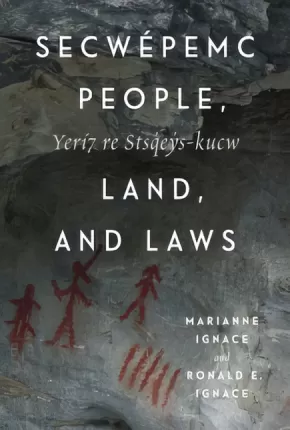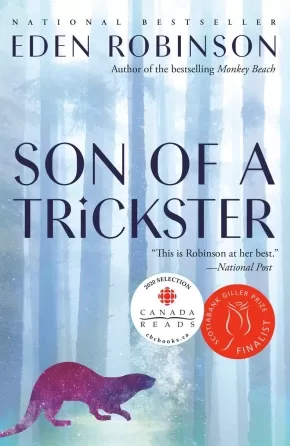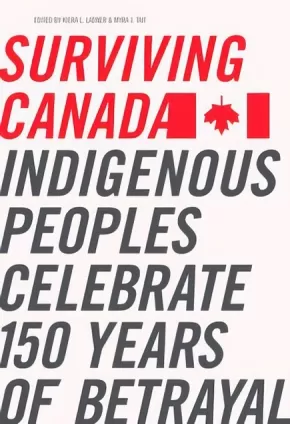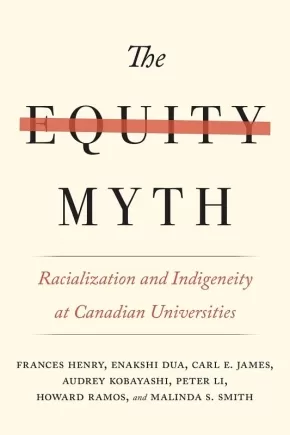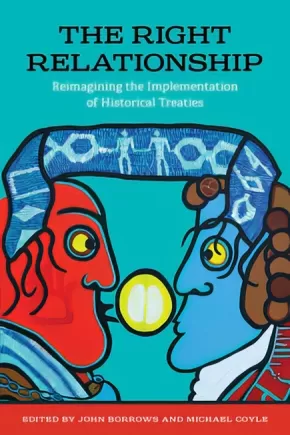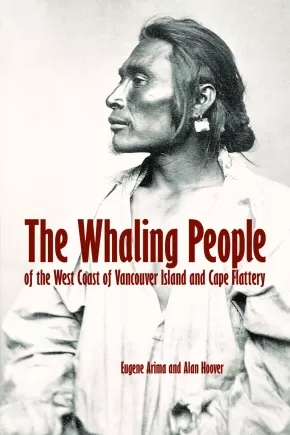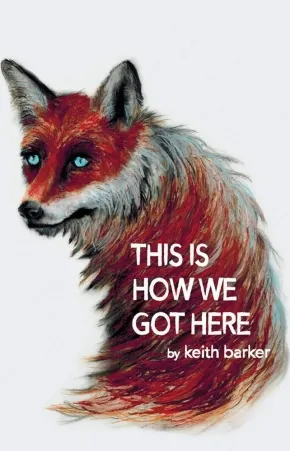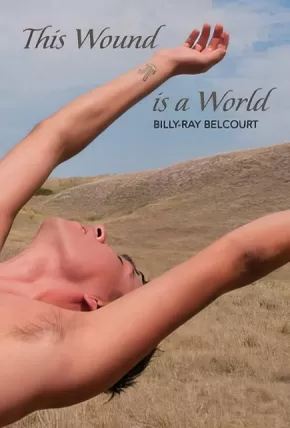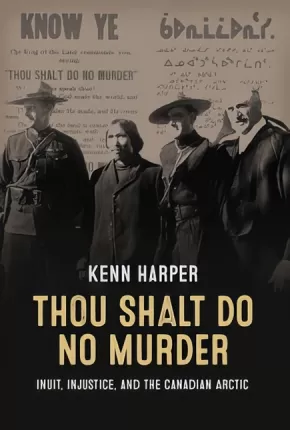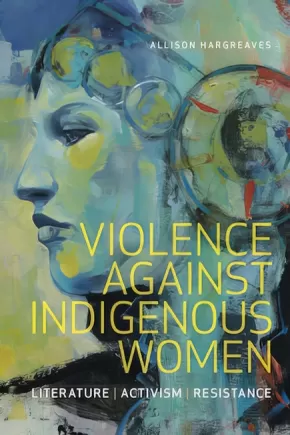
Indigenous Peoples in Canada
841
-
855
of
1085 Results;
Sort By
Go To
of 73
Secwepemc People, Land, and Laws: Yeri7 re Stsq'ey's-kucw
$49.95
Format:
Hardcover
Text Content Territories:
Indigenous Canadian; First Nations; Salish; Interior Salish; Secwepemc (Shuswap);
Grade Levels: University/College;
ISBN / Barcode: 9780773551305
Synopsis:
Synopsis:
Secwépemc People, Land, and Laws is a journey through the 10,000-year history of the Interior Plateau nation in British Columbia. Told through the lens of past and present Indigenous storytellers, this volume detail how a homeland has shaped Secwépemc existence while the Secwépemc have in turn shaped their homeland. Marianne Ignace and Ronald Ignace, with contributions from ethnobotanist Nancy Turner, archaeologist Mike Rousseau, and geographer Ken Favrholdt, compellingly weave together Secwépemc narratives about ancestors’ deeds. They demonstrate how these stories are the manifestation of Indigenous laws (stsq'ey') for social and moral conduct among humans and all sentient beings on the land, and for social and political relations within the nation and with outsiders. Breathing new life into stories about past transformations, the authors place these narratives in dialogue with written historical sources and knowledge from archaeology, ethnography, linguistics, earth science, and ethnobiology. In addition to a wealth of detail about Secwépemc land stewardship, the social and political order, and spiritual concepts and relations embedded in the Indigenous language, the book shows how between the mid-1800s and 1920s the Secwépemc people resisted devastating oppression and the theft of their land, and fought to retain political autonomy while tenaciously maintaining a connection with their homeland, ancestors, and laws. An exemplary work in collaboration, Secwépemc People, Land, and Laws points to the ways in which Indigenous laws and traditions can guide present and future social and political process among the Secwépemc and with settler society.
Son of a Trickster (PB)
$23.00
Format:
Paperback
Text Content Territories:
Indigenous Canadian; First Nations; Haisla (Kitamaat);
ISBN / Barcode: 9780345810793
Synopsis:
Synopsis:
Shortlisted for the Scotiabank Giller Prize: With striking originality and precision, Eden Robinson, the author of the classic Monkey Beach and winner of the Writers’ Trust of Canada Fellowship, blends humour with heartbreak in this compelling coming-of-age novel. Everyday teen existence meets indigenous beliefs, crazy family dynamics, and cannibalistic river otters...The exciting first novel in her trickster trilogy.
Everyone knows a guy like Jared: the burnout kid in high school who sells weed cookies and has a scary mom who's often wasted and wielding some kind of weapon. Jared does smoke and drink too much, and he does make the best cookies in town, and his mom is a mess, but he's also a kid who has an immense capacity for compassion and an impulse to watch over people more than twice his age, and he can't rely on anyone for consistent love and support, except for his flatulent pit bull, Baby Killer (he calls her Baby)--and now she's dead.
Jared can't count on his mom to stay sober and stick around to take care of him. He can't rely on his dad to pay the bills and support his new wife and step-daughter. Jared is only sixteen but feels like he is the one who must stabilize his family's life, even look out for his elderly neighbours. But he struggles to keep everything afloat...and sometimes he blacks out. And he puzzles over why his maternal grandmother has never liked him, why she says he's the son of a trickster, that he isn't human. Mind you, ravens speak to him--even when he's not stoned.
You think you know Jared, but you don't.
Reviews
“Eden Robinson’s Son of a Trickster is a novel that shimmers with magic and vitality, featuring a compelling narrator, somewhere between Holden Caulfield and Harry Potter. Just when you think Jared’s teenage journey couldn’t be more grounded in gritty, grinding reality, his addled perceptions take us into a realm beyond his small-town life, somewhere both seductive and dangerous. Energetic, often darkly funny, sometimes poignant, this is a book that will resonate long after the reader has devoured the final page.” —2017 Scotiabank Giller Prize jury (André Alexis, Anita Rau Badami, Lynn Coady, and Richard Beard)
Educator & Series Information
This is the first book in Eden Robinson's Trickster Trilogy. It is followed by Trickster Drift.
Grades 11-12 BC English First Peoples resource for the unit What Creates Family.
Note: This novel contains mature subject matter, such as drug use and depictions of sex and violence.
This book is available in French: Le fils du Trickster
Additional Information
336 pages | 5.20" x 8.00" | Paperback
Surviving Canada: Indigenous Peoples Celebrate 150 Years of Betrayal
$35.00
Editors:
Format:
Paperback
Text Content Territories:
Indigenous Canadian;
Grade Levels: University/College;
ISBN / Barcode: 9781894037891
Synopsis:
Synopsis:
Surviving Canada: Indigenous Peoples Celebrate 150 Years of Betrayal is a collection of elegant, thoughtful, and powerful reflections about Indigenous Peoples' complicated, and often frustrating, relationship with Canada, and how--even 150 years after Confederation--the fight for recognition of their treaty and Aboriginal rights continues.
Through essays, art, and literature, Surviving Canada examines the struggle for Indigenous Peoples' to celebrate their cultures and exercise their right to control their own economic development, lands, water, and lives.
The Indian Act, Idle No More, and the legacy of residential schools are just a few of the topics covered by a wide range of elders, scholars, artists, and activists. Contributors include Mary Eberts, Buffy Sainte-Marie, and Leroy Little Bear.
Reviews
"Published to coincide with celebrations of the 150th anniversary of Canadian confederation, this insightful compendium of largely Indigenous voices challenges all Canadians to improve relations with and conditions for the continents First Nations Peoples. Poems, essays, interviews, song lyrics, and illustrations bring razor-sharp clarity to historic and contemporary issues, including the shameful history of residential schools, current reconciliation efforts, conflicts over resource development, and how best to confront legacies of racism and colonialism. The editors' aim to provide an accessible educational tool is well-served by coverage of diverse topics, including over-representation of Indigenous people in prison, land dispossession, and how social amnesia prevents progress. Equally impressive is the recovery of repressed histories, such as First Nation women's suffrage struggles, how the city of Winnipeg was built with stolen water, and the critical battle to preserve language rights. Contributors including the late actor Chief Dan George, singer-songwriter Buffy Saint-Marie, and a number of writers and activists, such as Erica Violet Lee and Helen Knott share feelings of anger and disappointment at past and ongoing injustices, as well as an incredible hope that insistent resilience that has marked Indigenous existence in Canada will help spark a new awakening for all Canadians." - Publishers Weekly
Additional Information
464 pages | 5.50" x 8.50"
The Amazing Mazie Baker: The Story of a Squamish Nation's Warrior Elder
$24.95
Format:
Paperback
Text Content Territories:
Indigenous Canadian; First Nations; Salish; Coast Salish; Squamish;
Reading Level: N/A
ISBN / Barcode: 9781987915068
Synopsis:
Synopsis:
In 1931, Mazie Antone was born into the Squamish Nation, a community caught between its traditional values of respect—for the land, the family and the band—and the secular, capitalistic legislation imposed by European settlers. When she was six, the police carried her off to St. Paul’s Indian Residential School, as mandated by the 1920 Indian Act. There, she endured months of beatings, malnourishment and lice infestations before her family collected Mazie and her siblings and fled across the border.
After the war, the family return to their home on the Capilano Reserve and Mazie began working at a cannery where she packed salmon for eleven years. Mazie married Alvie Baker, and together they raised nine children, but the legacy of residential school for Mazie and her generation meant they were alienated from their culture and language. Eventually Mazie reconnected with her Squamish identity and she began to mourn the loss of the old style of government by councils of hereditary chiefs and to criticize the corruption in the band leadership created in 1989 by federal legislation.
Galvanized by the injustices she saw committed against and within her community—especially against indigenous women, who were denied status and property rights—she began a long career of advocacy. She fought for housing for families in need; she pushed for transparency in local government; she defended ancestral lands; she shone a bright light into the darkest political corners. Her family called her ch’sken: Golden Eagle.
This intimate biography of a community leader illuminates a difficult, unresolved chapter of Canadian history and paints a portrait of a resilient and principled woman who faced down her every political foe, unflinching, irreverent, and uncompromising.
Additional Information
240 pages | 6.00" x 9.00" | Paperback
The Equity Myth: Racialization and Indigeneity at Canadian Universities
$34.95
Format:
Paperback
Text Content Territories:
Indigenous Canadian;
Grade Levels: University/College;
ISBN / Barcode: 9780774834896
Synopsis:
Synopsis:
The university is often regarded as a bastion of liberal democracy where equity and diversity are promoted and racism doesn’t exist. In reality, the university still excludes many people and is a site of racialization that is subtle, complex, and sophisticated. While some studies do point to the persistence of systemic barriers to equity and diversity in higher education, in-depth analyses of racism, racialization, and Indigeneity in the academy are more notable for their absence. The Equity Myth is the first comprehensive, data-based study of racialized and Indigenous faculty members’ experiences in Canadian universities.
Challenging the myth of equity in higher education, this book brings together leading scholars who scrutinize what universities have done and question the effectiveness of their equity programs. The authors draw on a rich body of survey data and interviews to examine the experiences of racialized faculty members across Canada who – despite diversity initiatives in their respective institutions – have yet to see changes in everyday working conditions. They also make important recommendations as to how universities can address racialization and fulfill the promise of equity in higher education.
A landmark study on racism in Canadian universities, The Equity Myth shows how the goal of achieving equity in higher education has been consistently promised, but never realized for racialized and Indigenous faculty members. It further reveals that the policies and diversity initiatives undertaken so far have only served to deflect criticism of a system that is doing little to change itself.
The book will be appeal to anyone interested in the issue of equity within the university setting. This includes faculty members from many disciplines; administrators at all levels; students and graduate students; and people interested in equity issues outside of academia.
Reviews
"[G]roundbreaking new research led by York University Professor Emeritus Frances Henry puts Canadian universities under the microscope. This new inquiry … shows that racialized and Indigenous faculty are low in numbers and even lower in terms of power, prestige and influence compared to non-racialized [white, male] counterparts within the university" — Megan Mueller, Manager, research communications, Office of the Vice-President Research & Innovation, York University
"The Equity Myth brings to the surface tensions that racialized faculty widely experience but seldom formally discuss in their workplaces. These include pay inequity, unequal hiring processes, a lack of visibility for racialized faculty in the professoriate, Euro-centric curricula and racial discrimination.
Until now, those tensions have been felt only in the abstract or anecdotally. Statistics Canada does not collect data on racialized minorities as part of the data it compiles on faculty and students at Canadian universities; nor do provincial governments collect such information. There has been recent change on this front from the University of Toronto and Ryerson University, both of which have announced in the past year that they would start collecting race-based data about their students. But no data exists on the effectiveness of university employment equity policies or policies against discrimination, despite their ubiquity across Canadian campuses." — Jackie Wong, University Affairs, November 2017
"The Equity Myth paints a bleak picture in which the hegemonic whiteness and patriarchy of the institution show remarkable resilience through lip service and tokenism. [...]On the other hand, it recommends possible concrete solutions[...]a must-read for anyone interested in the social sciences, in discrimination, or simply in being decent and well-informed human beings." — Sylvie Vrackx, Canadian Literature, May 2019
"This compelling and important text is the first of its kind in Canada. It provides rigorous and informative investigations of the status, representation, and everyday lived experiences of racialized and Indigenous scholars in English-speaking Canadian universities … I recommend this book not only for scholars but also for administrators serious about equity and institutional change." — Annette Henry, David Lam Chair in Multicultural Education and Professor in the Department of Language and Literacy Education and the Social Justice Institute, University of British Columbia
Educator Information
Related Topics: Education, Indigenous Studies, Post-Secondary Education, Race & Ethnicity; Sociology
Table of Contents
Preface and Acknowledgments
Additional Information
392 pages | 6.00" x 9.00" | 6 graphs, 33 tables
The Right Relationship
$45.95
Editors:
Format:
Paperback
Text Content Territories:
Indigenous Canadian;
Grade Levels: University/College;
ISBN / Barcode: 9781442630215
Synopsis:
Synopsis:
The relationship between Canada’s Indigenous peoples and the Canadian government is one that has increasingly come to the fore. Numerous tragic incidents and a legacy of historical negligence combined with more vehement calls for action is forcing a reconsideration of the relationship between the federal government and Indigenous nations.
In The Right Relationship, John Borrows and Michael Coyle bring together a group of renowned scholars, both indigenous and non-indigenous, to cast light on the magnitude of the challenges Canadians face in seeking a consensus on the nature of treaty partnership in the twenty-first century. The diverse perspectives offered in this volume examine how Indigenous people’s own legal and policy frameworks can be used to develop healthier attitudes between First Peoples and settler governments in Canada. While considering the existing law of Aboriginal and treaty rights, the contributors imagine what these relationships might look like if those involved pursued our highest aspirations as Canadians and Indigenous peoples. This timely and authoritative volume provides answers that will help pave the way toward good governance for all.
Additional Information
440 pages | 6.00" x 9.00"
The Whaling People of the West Coast of Vancouver Island and Cape Flattery
$19.95
Artists:
Format:
Paperback
Text Content Territories:
Indigenous Canadian; First Nations;
ISBN / Barcode: 9780772664914
Synopsis:
Synopsis:
The Whaling People live along the west coast of Vancouver Island and Cape Flattery in Washington. They comprise more than 20 First Nations, including the Nuu-chah-nulth (formerly called Nootka), Ditidaht, Pacheedaht and Makah. These socially related people enjoyed a highly organized, tradition-based culture for centuries before Europeans arrived. As whaling societies, they had a unique relationship with the sea.
In The Whaling People, Eugene Arima and Alan Hoover give an intimate account of the traditional ways in which these coastal people looked at and understood the world they lived in. They present the activities, technologies, and rituals that the Whaling People used to make a living in their complex coastal environments, and their beliefs about the natural and supernatural forces that affected their lives. The book features 12 narratives collected from First Nations elders, each illustrated with original drawings by the celebrated Hesquiaht artist Tim Paul.
This informative and entertaining book celebrates the still-thriving cultures of the Whaling People, who survived the devastating effects of colonial power and influences. It includes a history of treaty-making in BC, leading up to the just-ratified Maa-nulth Treaty signed by five First Nations of the Whaling People.
Additional Information
272 pages | 6.00" x 9.00"
Authenticity Note: Because of the artwork and narratives contributed to this work from First Nations elders and Hesquiaht artist Tim Paul, it has received the Authentic Text and Artwork labels. It's up to readers to determine if this work qualifies as authentic for their purposes.
The Winona LaDuke Chronicles: Stories from the Front Lines in the Battle for Environmental Justice
$25.00
Format:
Paperback
Text Content Territories:
Indigenous American; Indigenous Canadian;
ISBN / Barcode: 9781552669594
Synopsis:
Synopsis:
Chronicles is a major work, a collection of current, pressing and inspirational stories of Indigenous communities from the Canadian subarctic to the heart of Dine Bii Kaya, Navajo Nation. Chronicles is a book literally risen from the ashes—beginning in 2008 after her home burned to the ground—and collectively is an accounting of Winona’s personal path of recovery, finding strength and resilience in the writing itself as well as in her work. Long awaited, Chronicles is a labour of love, a tribute to those who have passed on and those yet to arrive.
Reviews
“Winona LaDuke’s latest book reads like a prayer. These are holy words— inspirational stories taken straight from the heart of indigenous communities throughout the world…(Chronicles) is lyrical, instructional, and infused with wry humor when the weight of the message becomes unbearable…LaDuke provides a roadmap through tribal nations’ belief systems; offering a spiritual compass and invaluable insight into the relationship of prophesy to the realities of climate change, economic collapse, food scarcity and basic human rights.” — Huffington Post
Educator Information
Recommended for students in grades 9 - 12, as well as those at a college/university level, for courses in science, environmental science, and social justice.
Additional Information
310 pages | 6.00" x 9.00"
These Are Our Legends
$24.95
Format:
Paperback
Text Content Territories:
Indigenous Canadian; First Nations; Salish; Interior Salish; St'at'imc (Lillooet, Lil'Wat);
Grade Levels: 12; University/College;
ISBN / Barcode: 9780889773967
Synopsis:
Synopsis:
Like all First Nations languages, Lillooet (Lil'wat) is a repository for an abundantly rich oral literature. In These Are Our Legends, the fifth volume of the First Nations Language Readers series, the reader will discover seven traditional Lillooet sptakwlh (variously translated into English as "legends," "myths," or "bed-time stories.")
These texts are presented in a technical transcription that can be used by linguists, and also in a practical orthography that can be used by Lillooet speakers themselves. An English translation is also given. Basic information on the Lillooet language, its grammar, and a glossary are included in the volume.
With thanks to the Mount Currie Cultural Centre and the Tszil Publishing House.
Series Information
These Are Our Legends is part of the First Nations Language Readers series. With a mix of traditional and new stories, each First Nations Language Reader introduces an Indigenous language and demonstrates how each language is used today. The University of Regina Press’s long-term goal is to publish all 60+ Indigenous languages of Canada.
Additional Information
120 pages | 5.50" x 8.50" | Narrated by Lillooet Elders | Transcribed and Translated by Jan van Eijk
Authenticity Note: This book has been labelled as containing Authentic Indigenous Text because of the narration from Lillooet Elders. It is up to readers to determine if this text will work as an authentic resource for their purposes.
This Accident of Being Lost: Songs and Stories
$19.95
Format:
Paperback
Text Content Territories:
Indigenous Canadian; First Nations; Anishinaabeg;
Grade Levels: University/College;
ISBN / Barcode: 9781487001278
Synopsis:
Synopsis:
This Accident of Being Lost is the knife-sharp new collection of stories and songs from award-winning Nishnaabeg storyteller and writer Leanne Betasamosake Simpson. These visionary pieces build upon Simpson's powerful use of the fragment as a tool for intervention in her critically acclaimed collection Islands of Decolonial Love. Provocateur and poet, she continually rebirths a decolonized reality, one that circles in and out of time and resists dominant narratives or comfortable categorization. A crow watches over a deer addicted to road salt; Lake Ontario floods Toronto to remake the world while texting "ARE THEY GETTING IT?"; lovers visit the last remaining corner of the boreal forest; three comrades guerrilla-tap maples in an upper middle-class neighbourhood; and Kwe gets her firearms license in rural Ontario. Blending elements of Nishnaabeg storytelling, science fiction, contemporary realism, and the lyric voice, This Accident of Being Lost burns with a quiet intensity, like a campfire in your backyard, challenging you to reconsider the world you thought you knew.
Educator Information
Recommended for ages 16 and up.
Curriculum Connections: English, Indigenous Studies, History, Humanities and Social Sciences.
This Is How We Got Here
$17.95
Format:
Paperback
Text Content Territories:
Indigenous Canadian;
Reading Level: n/a
ISBN / Barcode: 9781770918221
Synopsis:
Synopsis:
Simultaneously heartbreaking and heartwarming, This is How We Got Here follows a close-knit family as they deal with an unexpected loss. A mother, father, aunt, and uncle must learn how to move forward after the trauma and re-learn how to interact with one another with forgiveness, humour, and love.
It’s been a year since Paul and Lucille’s son Craig died by suicide, and their once-solid family bonds are starting to break down. While the now-separated couple tries to honour their son, Lucille’s sister Liset and her husband Jim refuse to discuss their nephew. The ties that keep the four together as sisters, best friends, and spouses are strained by grief and guilt… until a visit from a fox changes everything.
Reviews
“While the material of This is How We Got Here is deep, the show didn’t leave me feeling anything dark. Instead, I was happy to have experienced the talent of everyone involved, and to have gained perspective on what I felt were honest and true reactions to the tragedy of suicide.” — Jeff Kerr, Mooney on Theatre
Additional Information
104 pages | 5.40" x 8.35" | Paperback
This Wound is a World
$19.95
Format:
Paperback
Text Content Territories:
Indigenous Canadian;
Grade Levels: 12; University/College;
ISBN / Barcode: 9781927823644
Synopsis:
Synopsis:
Part manifesto, part memoir, This Wound is a World is an invitation to “cut a hole in the sky to world inside.” Billy-Ray Belcourt issues a call to turn to love and sex to understand how Indigenous peoples shoulder sadness and pain like theirs without giving up on the future. His poems upset genre and play with form, scavenging for a decolonial kind of heaven where “everyone is at least a little gay.”
Awards
- 2018 Griffin Poetry Prize
- 2018 Indigenous Voices Award - Most Significant Work of Poetry in English
Reviews
"In This Wound is a World, love answers heartbreak, “history lays itself bare” (42) and a world glimmering with decolonial love and queer, Indigenous possibilities is split open. This is poetry at its brightest. It is electric, profound, necessary work. Belcourt bends genre, challenging the cage of colonialism through a poetics of intimacy. It is a collection unafraid to ask questions, exploring grief, desire, queer sexuality and Indigeneity with tender honesty. Belcourt asks us to consider the ways Indigenous bodies can be simultaneously unbound and “rendered again,” (40) how worlds can be made and unmade. These are poems to be returned to again and again with reverence." - PRISM International
Additional Information
64 pages | 6.00" x 9.00"
Thou Shalt Do No Murder: Inuit, Injustice, and the Canadian Arctic
$38.95
Format:
Hardcover
Text Content Territories:
Indigenous Canadian; Inuit;
Grade Levels: University/College;
ISBN / Barcode: 9781897568491
Synopsis:
Synopsis:
High Arctic, 1920: Three Inuit men delivered justice to an abusive Newfoundland trader.
This is the story of fur trade rivalry and duplicity, isolation and abandonment, greed and madness, and a struggle for the affections of an Inuit woman during a time of major social change in the High Arctic.
A show trial was held in Pond Inlet in 1923 that marked an end to the Inuit traditional way of life and ushered in an era in which Inuit autonomy was supplanted by dependence on traders and police, and later missionaries.
Kenn Harper draws on a combination of Inuit oral history, archival research, and his own knowledge acquired through 50 years in the Arctic to create a compelling story of justice and injustice in the far north.
Reviews
"While the amount of background information sometimes threatens to overwhelm the actual trial, this material is so interesting — and Harper's writing so vibrant — that it does not impede the narrative, or preclude thought-provoking questions about Canada's long-standing and ongoing negative treatment of the Inuit."— Quill & Quire
Additional Information
400 pages | 6.00" x 9.00" | 70 photos | Bibliography | Index
Through Different Eyes
$19.95
Format:
Paperback
Text Content Territories:
Indigenous Canadian; First Nations;
ISBN / Barcode: 9781773240060
Synopsis:
Synopsis:
Everyone knows everyone's business in the small fishing community of Kitsum. So when young Brenda Joe fears she might be pregnant, she also worries that rumours will spread quickly. Things look up when Brenda's favourite aunt, Monica returns to Kitsum for Christmas, although she is preoccupied with her own relationship problems. It's become clear to her that the white man she's been living with in Vancouver sees her as his "Indian Princess," his own exotic arm candy, and she's had enough. When she learns about Brenda's secret relationship with a local man, Monica is appalled and goes to set him straight. But is there more to this attractive loner and his hard-partying relations than meets the eye? Come spring, amid their secrets and betrayals, each family member will be tempted down to the water to collect herring eggs from artfully placed hemlock branches. The question is, will they be able to face one another?
Educator Information
Recommended in the Canadian Indigenous Books for Schools 2019-2020 resource list for grades 9 to 12 for English Language Arts.
This work contains topics of substance abuse, sexuality, adultery, and child neglect that are not the focus of the story but still a part of it.
Additional Information
288 pages | 5.25" x 8.00"
Authenticity Note: Karen Charleson is a member of the House of Kinquashtakumlth and the Hesquiaht First Nation through marriage. We have applied the Authentic Indigenous Text label for this reason; however, readers will need to determine if this work is authentic for their purposes.
Violence Against Indigenous Women: Literature, Activism, Resistance
$29.99
Format:
Paperback
Text Content Territories:
Indigenous Canadian;
Grade Levels: University/College;
ISBN / Barcode: 9781771122399
Synopsis:
Synopsis:
Violence against Indigenous women in Canada is an ongoing crisis, with roots deep in the nation’s colonial history. Despite numerous policies and programs developed to address the issue, Indigenous women continue to be targeted for violence at disproportionate rates. What insights can literature contribute where dominant anti-violence initiatives have failed? Centring the voices of contemporary Indigenous women writers, this book argues for the important role that literature and storytelling can play in response to gendered colonial violence.
Indigenous communities have been organizing against violence since newcomers first arrived, but the cases of missing and murdered women have only recently garnered broad public attention. Violence Against Indigenous Women joins the conversation by analyzing the socially interventionist work of Indigenous women poets, playwrights, filmmakers, and fiction-writers. Organized as a series of case studies that pair literary interventions with recent sites of activism and policy-critique, the book puts literature in dialogue with anti-violence debate to illuminate new pathways toward action.
With the advent of provincial and national inquiries into missing and murdered Indigenous women and girls, a larger public conversation is now underway. Indigenous women’s literature is a critical site of knowledge-making and critique. Violence Against Indigenous Women provides a foundation for reading this literature in the context of Indigenous feminist scholarship and activism and the ongoing intellectual history of Indigenous women’s resistance.
Reviews
“This book makes an important – indeed, urgent – contribution to knowledge about violence against Indigenous women that ought to become required reading for politicians, activists, policy-makers, scholars, writers, and artists engaged in responding to this ongoing crisis.”
— Amber Dean, McMaster University, author of Remembering Vancouver’s Disappeared Women: Settler Colonialism and the Difficulty of Inheritance
"Hargreaves ... examines how stories of individual tragedies have been memorialized in venues such as human rights reports, poems, films, and plays. She convincingly explains that statistics and research projects produced with the best intentions may serve to reinforce the very colonial power dynamics that prevent the emergence of transformative solutions in the struggle to end violence against Indigenous women. ... For those in the field of comparative narrative criticism, it’s a work sure to inspire much discussion, debate, and reflection."
— Publisher's Weekly
Educator Information
This book would be useful for Indigenous Studies, Women's Studies, Literary Criticism, and Canadian Literature courses, or courses where activism is a key theme.
Additional Information
296 pages | 6.00" x 9.00"
Sort By
Go To
of 73

